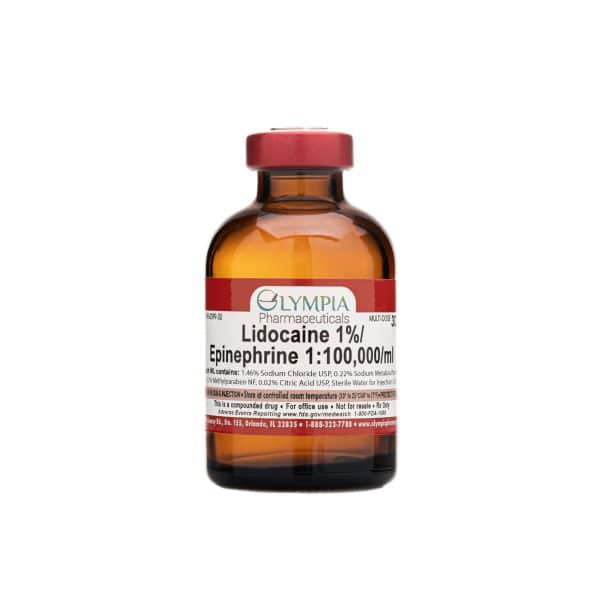Overview
Lidocaine with epinephrine is an anesthetic used to numb an area of the body to help reduce pain and discomfort caused by medical procedures. Lidocaine and epinephrine come in many different forms, such as creams, patches, lotions, sprays, gels, and liquids. Lidocaine with epinephrine is typically given by a healthcare professional just prior to a procedure. Epinephrine is added for its vasoconstricting properties, which helps reduce bleeding during the procedure. Some research has shown that epinephrine also increases the duration of lidocaine.
What Is Lidocaine HCL 1% with Epinephrine Used For?
Lidocaine and epinephrine injections are powerful local anesthetics used to relieve pain and discomfort by numbing the area of the body into which it is injected. It is often administered prior to dermatological and vein procedures to reduce pain. The addition of epinephrine enhances the anesthetic’s effectiveness by constricting blood vessels, prolonging numbness and minimizing bleeding.
Common uses for Lidocaine HCl 1% with epinephrine include minor surgical procedures, such as skin lesion removal, biopsies and wound suturing, as well as dental procedures, such as tooth extractions, fillings and root canals.
Dosage, Concentration, Route of Administration
Dosage: Seek advice from a licensed physician, medical director, or other healthcare provider
Concentration: Lido 1%/EPI 1:100,00/ml
Route of Administration: IM/IV/Sub-Q
Precautions/Side Effects
It is very important to speak with your doctor while receiving this medication to make sure it is working properly. Blood tests may be needed to check for unwanted effects. This medicine may cause a rare but serious blood condition called methemoglobinemia. It is more likely to occur in those patients receiving too much of the medicine but can occur with small doses as well. Make sure any doctor or dentist who treats you knows you are using this medication, as it may affect the results of certain medical tests. Speak with your doctor about any allergies you have to this medication or any other types, such as to foods, dyes, preservatives, or animals. For those who are breastfeeding, there are no adequate studies determining the risk epinephrine has to infants during breastfeeding. Weigh the potential benefits against the potential risks before taking this medication. Do not take this medication with any other medicines unless you have discussed it with your physician. This includes prescriptions, over-the-counter medicines, or herbal/vitamin supplements.
Some common side effects include:
- – Cold or numb feeling
- – Vomiting
- – False or unusual sense of well-being
- – Feeling of heat
- – Loss of bladder and bowel control
- – Loss of genital sensation and sexual function
- – Nervousness
Speak with your physician if any of these common side effects continue or are bothersome.
Check with your healthcare provider if any of the following occur:
- – Bluish-colored lips, fingernails, or palms
- – Blurred or double vision
- – Chest pain or discomfort
- – Cold, clammy, pale skin
- – Confusion
- – Continuing ringing or buzzing, or other unexplained noise in the ears
- – Cough
- – Dark urine
- – Difficulty breathing or swallowing
- – Dizziness/lightheadedness
- – Drowsiness
- – Fast heartbeat
- – Fever
- – Headache
- – Hearing loss
- – Hives, itching, skin rash
- – Irregular heartbeat or breathing
- – Puffiness/swelling of the eyelids/eyes, face, lips, or tongue
- – Sore throat
- – Seizures
- – Sweating
- – Tremor or twitching
- – Unusual bleeding or bruising
- – Unusual tiredness or weakness
Storage
Store at controlled room temperature. Protect from light.
Ready to Learn More About Lidocaine 1% with Epinephrine? Contact Olympia Pharmacy Today!



